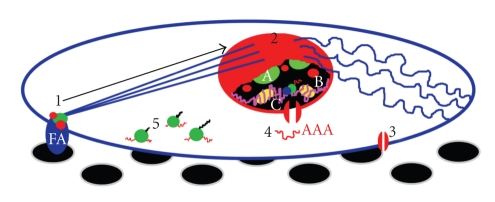Figure 3.
Summary of potential mechanical effects of nanotopography on a generic cell of mesenchymal origin. (1) Cell sensing of the nanotopographical stimulus (black circles) is initiated at focal adhesions (FA), with protein recruitment, force-induced changes in protein conformation and binding at these sites, cytoskeletal remodelling and indirect chemical signalling to the nucleus (arrow). (2) Physical forces from the cytoskeleton, including tension from actin stress fibres (straight lines) and interactions between actin and the intermediate filaments vimentin (wavy lines) and the lamins (red) induce direct mechanotransductive effects. Together with signalling inputs, these changes may include redistribution of chromosomes, nucleoli (A), and other nuclear components (B), epigenetic changes to DNA (pink) and histones (yellow), and accessibility of DNA to the transcriptional machinery (C). (3) Ion channels and certain membrane proteins may also be responsive to the nanofeatures, leading to ion fluxes and additional signals. (4) The diameter of nuclear pores (red channel) may be manipulated by force from the cytoskeleton, potentially affecting mRNA transport. (5) Availability of mRNA, or other modulation of translation, could alter protein production from ribosomes.

